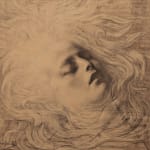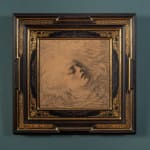Jean Delville Belgian, 1867-1953
Jean Delville is considered one of the most important figures of the Belgian avant-garde at the end of the century. He is known for his painting which played a major role in the development of Symbolist art but also for his poetic and philosophical writings as well as for having founded the group Pour l'Art , an avant-garde Symbolist salon. He has exhibited alongside artists such as Fernand Khnopff, James Ensor and Theo van Rysselberghe. He participated in the first Salon de la Rose + Croix in Paris in 1892 and the following year, he presented at this Salon, created by Joséphin Péladan, one of his masterpieces, Orphée Mort , now kept at the museum of Fine Arts in Brussels (inv. 12209).
Our drawing is a variation or a first thought of this same subject which greatly inspired Delville. The painter is inspired by the myth of Orpheus to create images that match his ambitions and those of his Symbolist contemporaries, powerfully evocative visions in reaction against the art of their time which they consider too empirical and down-to-earth. earth. Drawing inspiration from myths and legends allows us to achieve this, and the myth of Orpheus in particular. Orpheus, after having seduced Pluto and Proserpina with his music, is authorized to take his wife Eurydice out of the Underworld, but he must not look at her before he has come out. Orpheus, unable to resist temptation, dies. The hero is then dismembered by maenads who abandon his floating head adrift. It is this head that Delville chooses to represent, that of the life which disappears, that of the seductive musician, that of the one who did not resist temptation, but also an unreal motif of a head without a body, of an ideal beauty in a fantastic context, the artist does not give a key to reading, he invites contemplation, reflection and meditation.



